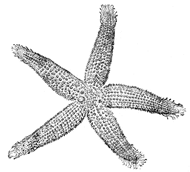 What Is a Keystone Species?
What Is a Keystone Species?

A keystone species is a plant or animal that plays a unique and (1)crucial role in the way an ecosystem functions. Without keystone species, the ecosystem would be dramatically different or cease to exist altogether. A small number of keystone species can have a huge impact on the environment.
A keystone species is often a predator. A few predators can control the distribution and population of large numbers of prey species. A single mountain lion can roam a Canadian forest area of hundreds of miles. The deer, rabbits, and bird species in the ecosystem are at least partly controlled by the presence of the mountain lion. Their feeding behavior, or where they choose to make their nests and burrows, are largely a reaction to the mountain lion's activity. (2)Scavenger species, such as vultures, are also controlled by the activity of the mountain lion because lions leave behind carcasses for them to feed on.
A keystone species' disappearance would start a (3)domino effect. For example, the population of deer or rabbits could explode without the presence of a predator. The ecosystem cannot support an unlimited number of animals, and the deer soon compete with each other for food and water resources. Their population usually declines without a predator such as a mountain lion.
 Without the keystone species, new plants or animals could also come into the habitat and push out the (4)native species. Some species of hummingbirds are keystone species in the Sonoran Desert of North America. Hummingbirds pollinate native cactus. In areas of the Sonoran Desert with few hummingbirds, (5)invasive species such as buffelgrass have taken over the ecosystem.
Without the keystone species, new plants or animals could also come into the habitat and push out the (4)native species. Some species of hummingbirds are keystone species in the Sonoran Desert of North America. Hummingbirds pollinate native cactus. In areas of the Sonoran Desert with few hummingbirds, (5)invasive species such as buffelgrass have taken over the ecosystem.
The theory that the balance of ecosystems can rely on one keystone species was first established in 1969 by American zoology professor Robert T. Paine. Paine's research showed that removing one species, the Pisaster ochraceus, or the sea star, had a huge effect on the surrounding ecosystem. The sea stars are a major predator for mussels, so when the sea stars were gone, mussels took over the area and crowded out other species. In the end, the area had less (6) biodiversity than it had before the sea stars were removed.
The sea otter is another example of a keystone species in the Pacific Northwest. These mammals feed on sea urchins, controlling their population. If the otters didn't eat the urchins, the urchins would (7) consume the habitat's kelp. Kelp is a type of giant seaweed and a major source of food and shelter for the ecosystem. Some species of crabs, snails, and geese depend on kelp for food. Many types of fish use the huge kelp forests to hide from predators. Without sea otters to control the urchin population, the entire ecosystem would collapse.
Herbivores can also be keystone species. In African savannas, elephants are a keystone species. Elephants eat small trees that grow on the savanna, they can even knock the trees over to get to their leaves. This feeding behavior keeps the savanna a grassland and not a forest. With elephants to control the tree population, grasses (8) thrive and sustain grazing animals such as antelopes, wildebeests, and zebras. Smaller animals such as mice and shrews are able to burrow in the warm, dry soil of a savanna. Predators such as lions and hyenas depend on the savanna for prey. Elephants are the keystone species that maintain the entire savanna ecosystem.
1. The passage above describes the interactions of several ecosystems, what is the overall theme of the entire article?
a) to compare the food chains of each ecosystem
b) to convince the reader to protect the environment
c) to explain what keystone species are important in each ecosystem
* UNDERLINE the sentence that serves as the topic sentence or thesis for the article.
2. Choose either the kelp forest of the Pacific Northwest, the Canadian Forest, or the African Savanna, then using the information provided in the article, sketch a food chain (or web) for that ecosystem.
3. In all ecosystems, what happens when the keystone species is removed?
a) the ecosystem collapses
b) the ecosystem becomes more healthy
c) there are more plants and greater productivity
* Underline and place a STAR ![]() next to sentences that provide evidence for this. Find at least 2.
next to sentences that provide evidence for this. Find at least 2.
4. Years ago, hunters near Yellowstone did not like wolves that competed with them for deer and elk kills. Wolf hunts reduced the population to near extinction, but the elks did not increase in number, and in some areas, their numbers declined when food sources ran out. What suggestion would you make to restore the ecosystem in that area?
5. What species took over the desert ecosystem when the hummingbirds were removed? ________________
In the passage, several words are numbered and underlined. Use the CONTEXT of the article to match the underlined word with its definition. If you are really stuck, you can use a dictionary.
b. to do well
c. species that naturally lives in a space
d. large variety
e. eats dead things
f. species that does not belong
g. important
h. to eat
1. _____ crucial
2. _____ scavenger
3. _____ domino
4. _____ native
5. _____ invasive
6. _____ biodiversity
7. _____ consume
8. _____ thrive

